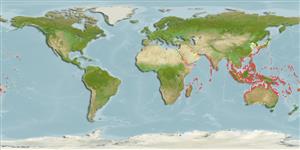Common names from other countries
Environment: milieu / climate zone / depth range / distribution range
Ecología
marino asociado a arrecife; rango de profundidad 0 - 60 m (Ref. 128797). Tropical; 42°N - 35°S, 20°E - 158°W
Indo-Pacific: East Africa to Micronesia and Samoa, north to southern Japan, south to New South Wales. Replaced by Arothron diadematus in the Red Sea (Ref. 37816, Ref. 84159).
Tamaño / Peso / Age
Maturity: Lm ? range ? - ? cm
Max length : 33.0 cm TL macho / no sexado; (Ref. 9710)
Espinas dorsales (total) : 0; Radios blandos dorsales (total) : 10 - 11; Espinas anales: 0; Radios blandos anales: 10 - 12. Body covered with prickles (Ref. 559) and with large black spots (Ref. 4919).
Inhabit coastal to outer reef crest and slopes with rich invertebrate growth. Sometimes solitary (Ref. 90102). Adults often in pairs (Ref. 48637). Feed on corals (usually Acropora tips), crustaceans, mollusks, sponges, tunicates and algae (Ref. 2334). Generally common (Ref. 9710).
Life cycle and mating behavior
Maturities | Reproducción | Spawnings | Egg(s) | Fecundities | Larva
Randall, J.E., G.R. Allen and R.C. Steene, 1990. Fishes of the Great Barrier Reef and Coral Sea. University of Hawaii Press, Honolulu, Hawaii. 506 p. (Ref. 2334)
IUCN Red List Status (Ref. 130435)
CITES (Ref. 128078)
Not Evaluated
Threat to humans
Poisonous to eat (Ref. 4690)
Human uses
Pesquerías: comercial; Acuario: Acuarios públicos
Herramientas
Special reports
Download XML
Fuentes de Internet
Estimates based on models
Preferred temperature (Ref.
115969): 24.7 - 29.3, mean 28.4 (based on 3101 cells).
Phylogenetic diversity index (Ref.
82804): PD
50 = 0.5000 [Uniqueness, from 0.5 = low to 2.0 = high].
Bayesian length-weight: a=0.03715 (0.01569 - 0.08798), b=2.87 (2.70 - 3.04), in cm Total Length, based on LWR estimates for this Genus-body shape (Ref.
93245).
Nivel trófico (Ref.
69278): 3.4 ±0.5 se; based on diet studies.
Resiliencia (Ref.
120179): Alto, población duplicada en un tiempo mínimo inferior a 15 meses (Preliminary K or Fecundity.).
Fishing Vulnerability (Ref.
59153): Low vulnerability (23 of 100).
